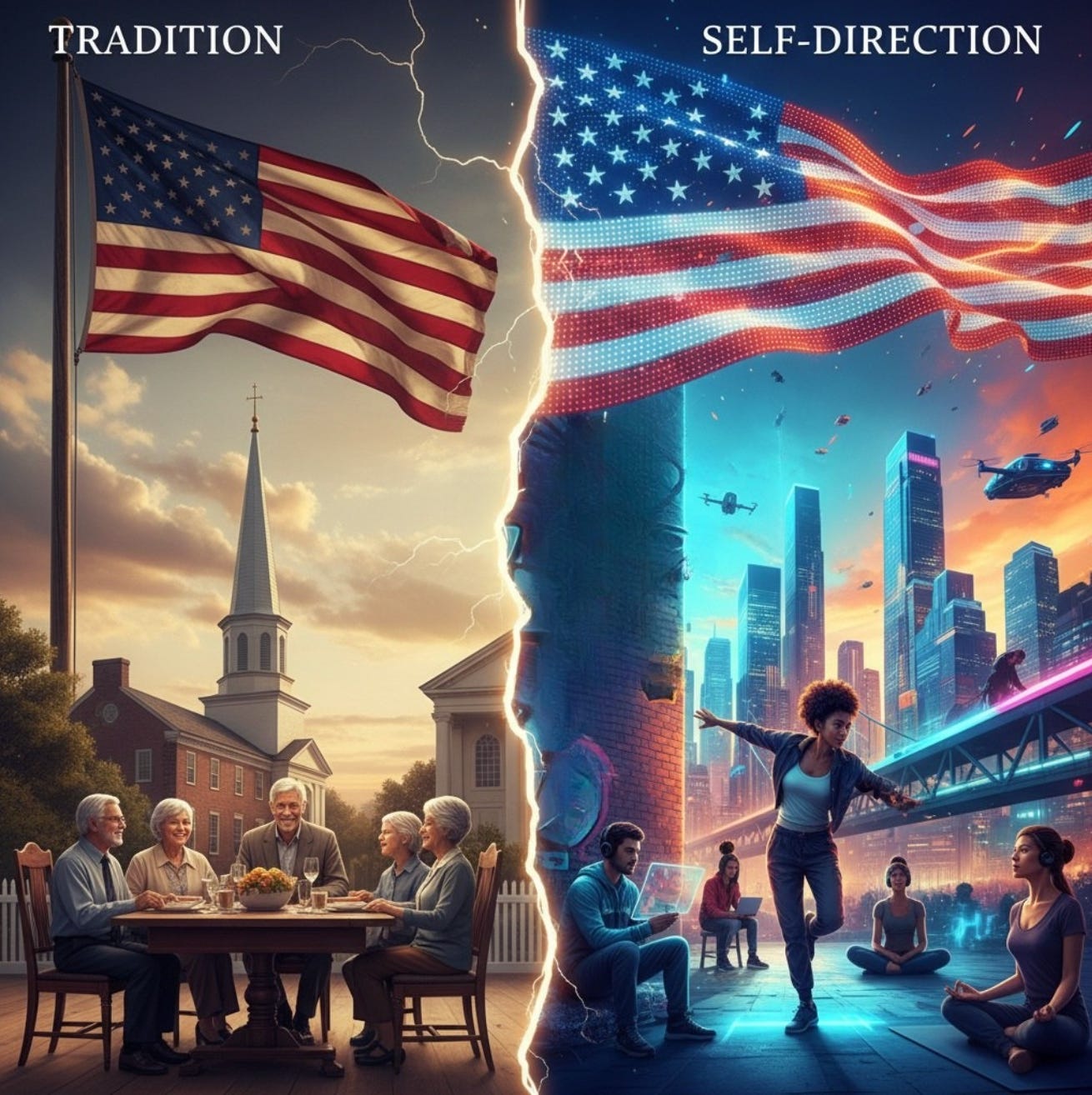America Must Choose: Tradition or Freedom
The fifth deep cultural rift in America today is about how people believe life should be lived.
The divide runs along a fault line that the cultural theorist Shalom Schwartz called one of the ten universal value types: Tradition versus Self-Direction.
Two Competing Visions of Life
On one side are those who emphasize Tradition.
Republicans often appeal to religious values, family structures, patriotic rituals, and a skepticism of cultural change. The idea is that stability comes from anchoring life in the past, rituals, customs, and ‘truths’ based on traditions. Society functions best when people accept these guardrails because they provide continuity and stability.
On the other side are those who emphasize Self-Direction.
Democrats push for the freedom to choose your own destiny. This vision draws on the American values of rugged individualism, the freedom to worship—or not worship, the freedom to build your own family, freedom to decide your own future. It’s the promise of self-determination, defining who you are. Not being told who you are by tradition, government, or those in power.
These aren’t just policy preferences. They are completely different visions of how people should live their lives.
Why the Divide Feels So Threatening
The problem is that Tradition and Self-Direction are polar opposites.
The more one side pushes to preserve the past and dictate the boundaries of personal life, the more the other side doubles down on freedom and self-determination. Every step forward for one feels like a step backward for the other.
That’s why American debates spiral into culture wars. It’s not about right or wrong. It’s about whether the rules of life should be fixed by tradition or chosen by the individual.
When one side wins, the other feels like their entire worldview is under attack.
Both Sides Are Necessary
Yet here’s the catch: both Tradition and Self-Direction are essential for a functioning society.
Tradition provides stability. It roots people in shared rituals, stories, and values. It offers meaning and continuity across generations and provides stability.
Self-Direction drives innovation and happiness. It encourages incentive, creativity, and the pursuit of happiness.
The United States was built on both. Its founding fathers embedded the balance into the nation’s DNA. The Declaration of Independence declares:
“We hold these truths to be self-evident, that all men are created equal… endowed… with certain unalienable Rights… among these are Life, Liberty and the pursuit of Happiness.”
That is Self-Direction in its purest form, the right to chart one’s own course, not to be bound by the dictates of tradition or power.
But America also built institutions, ceremonies, and traditions that gave stability to this freedom.
Archetypes Behind the Divide
Hornby’s archetypes help explain why America’s split between Tradition and Self-Direction runs so deep.
On the Tradition side stand the Blue (Guardian), who insists on rules, order, and religious or cultural authority; the South (Worker), who relies on continuity and apprenticeship; and the Red (Mother), who upholds family and social stability. Together, they anchor society in what has always been.
On the Self-Direction side are the Yellow (Creative), driven by freedom of expression; the West (Sage), who seeks independent knowledge; and the Green (Caregiver) and East (Communicator), who build new paths of empathy and exchange. They encourage society to pursue exploration and autonomy.
When these archetypes collide, the conflict is not just political; it is psychological and cultural. America isn’t just fighting over policies. It’s fighting over which archetypal vision should define the future.
The Question for America
The danger now is that the country has forgotten the need for balance. Instead of holding Tradition and Self-Direction in tension, Americans have weaponized them against each other.
That’s why every Supreme Court ruling, every election, every new law feels like an existential threat. One side sees it as the loss of freedom. The other sees it as the erosion of stability.
So the question facing America today is simple, but profound:
Can the United States find a balance between Tradition and Freedom—or will it keep tearing itself apart?


